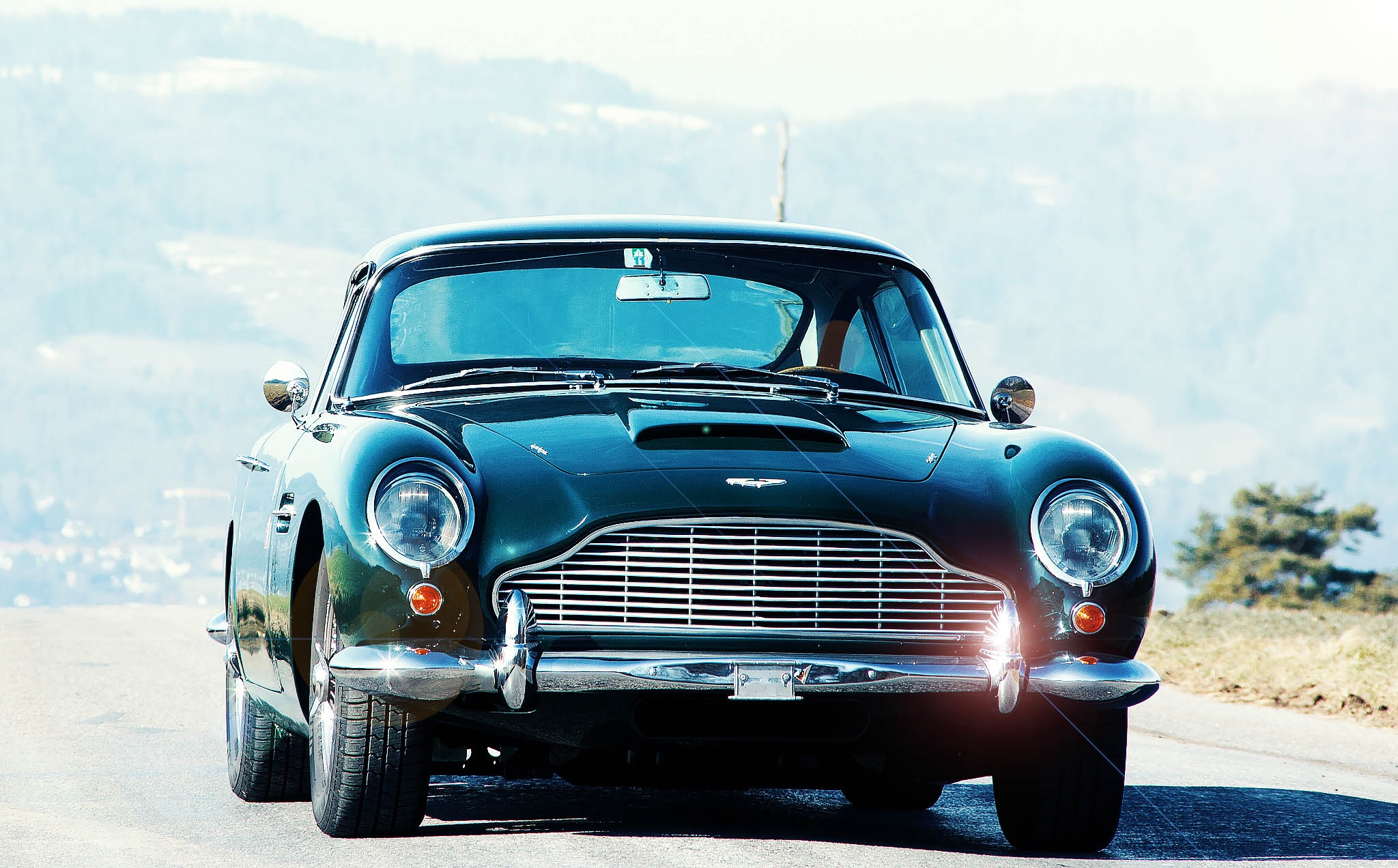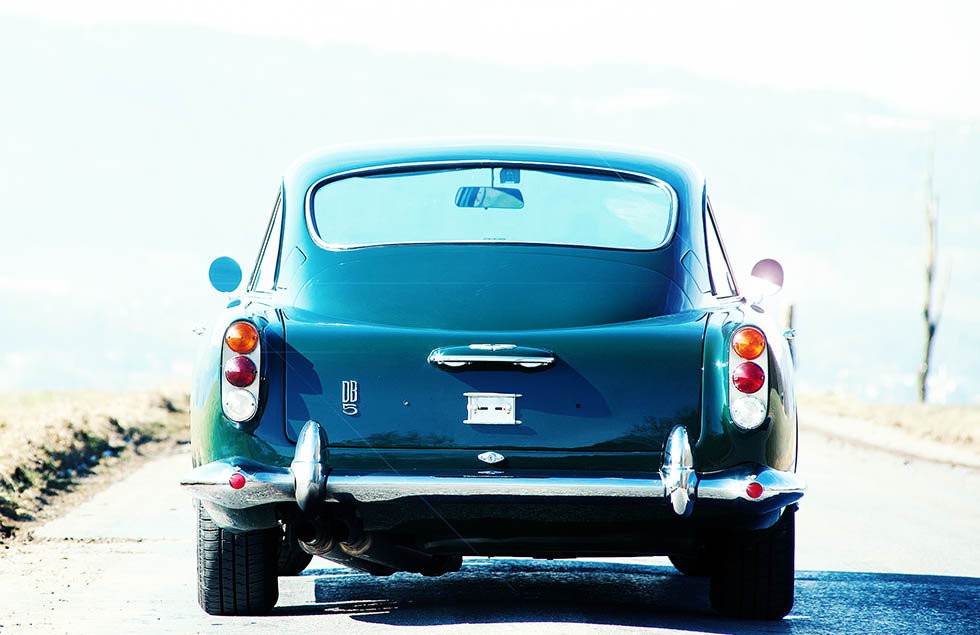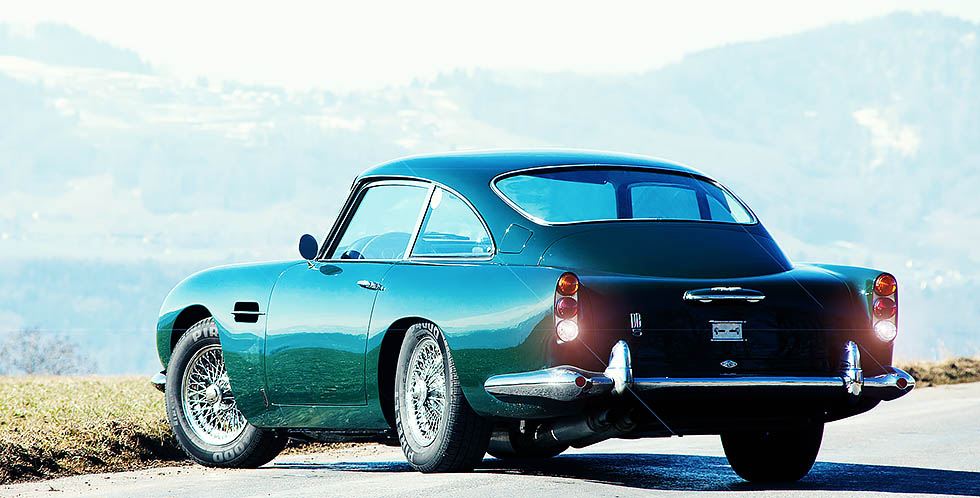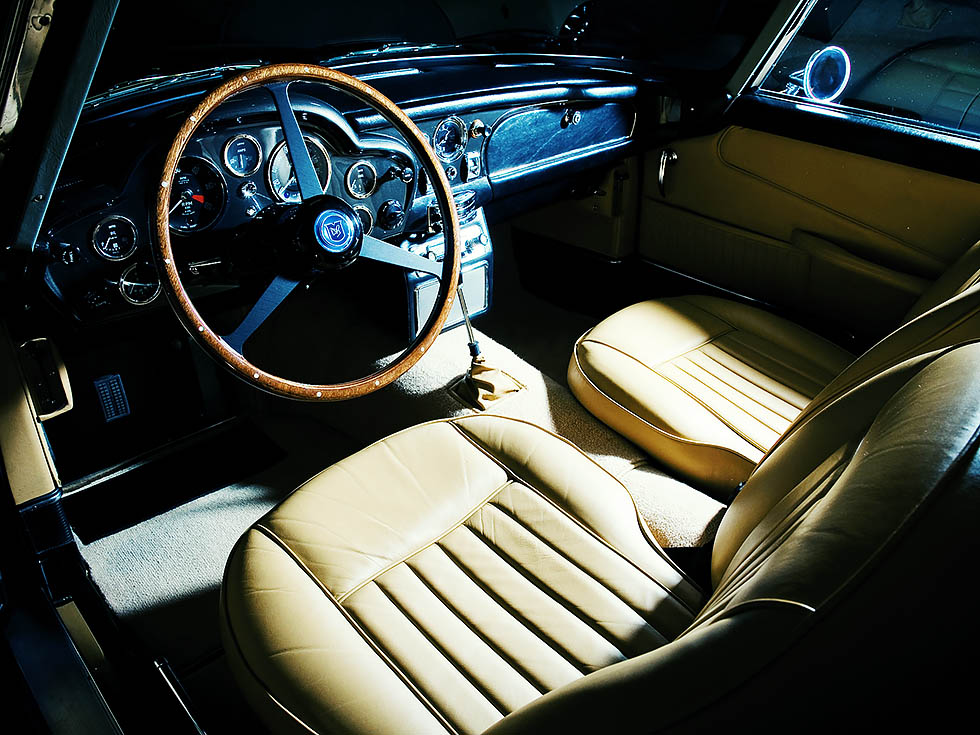
Like the fourth dimension, subjects and experiences beyond our personal comprehension are virtually impossible to visualize with any degree of reality. One naturally relates all things to the fixed values one has for comparison, and other people’s claims seldom ring true unless one knows for oneself. To be told 100mph (with certain qualifications) is a safe speed would cause a large majority of everyday motorists to throw up their hands in horror and launch forth on a counter-attack on the dangers of high-speed driving. Yet they could be silenced simply and forever by a short trip over ordinary trunk roads in an Aston Martin DBS.

More and ‘more cars today can reach the magical “ton,” but those which can do it with the ease and rapidity of the Aston can be counted on the fingers of one hand. High-speed stability and safety is not cheap to engineer, and with few people to pay the price, production costs are never reduced by the quantity of the work. The DB5 therefore fills a unique corner of the market, a corner at the top end both in the way it performs and the price one pays for the privilege.
It is a car which defies definition, for it can put on so many widely differing characters that it always seems tailored to one’s mood of the moment. Pottering home through a city’s evening exodus, whittling through strings of weekend tourists, or gobbling up great strips of concrete motorway like an Italian with a plate of spaghetti, the Aston makes all of these light work and always comes to the end asking for more.
Since our last test of the DB4 (13 October 1961) there have been a few changes to the mechanical specification, all introduced with the new model at the 1964 London Motor Show. A good deal of extra refinement was added, with the emphasis on comfort and quality, this putting the kerb weight up by over 2cwt; but a substantial increase in the cylinder capacity brought back all the performance, and more.
Briefly, by increasing the bore from 92mm to 96mm the capacity has been enlarged from 3,670 to 3,995 c.c. Net power output is up from 240 to 282 bhp at the same 5,500 rpm, and peak torque is raised from 240 to 280 lb. ft. at 4,500 rpm. A five-speed ZF gearbox is now a standard fitting, with a single dry plate Laycock diaphragm-spring clutch in place of the previous Borg and Beck twin-plate design. There has also been a change to Girling disc brakes on all four wheels instead of the Dunlop ones fitted all round before. There are divided hydraulic circuits for the front and rear systems, with a separate vacuum-servo for each and a warning lamp to show low fluid level in the reservoir for either of the tandem master cylinders.
The ZF gearbox has a direct fourth and a geared-up fifth with a ratio of 0.83 to 1. A final drive ratio lower than that with the four-speed box is fitted (3.77 instead of 3.31 to 1) giving roughly the same top gear mph per 1,000 rpm. To be precise, the earlier figure was 24.2 mph per 1,000 rpm for Avon Turbospeeds, which were the standard tyre equipment and the figure for the new car on Dunlop RS5s is 26.6. However, our car for some reason was shod with the latest Avon Turbospeed Mk. IVs which have a slightly smaller rolling radius and give a figure of 25.0. The Aston-Martin DB5 also uses smaller wheels and larger section tyres (6-70-15in. in place of 6-00-16in.) but this has little effect on the overall size.
For out-and-out maximum speed the Dunlops might prove slightly faster, because on our best one way run at 142.6 mph the rev counter needle was well into the red danger zone and reading 5,800 rpm. These facts are only of academic interest, however, for no owner is ever likely to extend his car to this limit very often. The handbook gives a maximum of 5,500 rpm (138 mph) for sustained running and up to 6,000 rpm momentarily in the gears, so we kept within these limits when measuring the acceleration. A check with the maximum speeds we measured in the gears at an indicated 6,000 rpm shows a slight optimism in the calibration of the car’s rev counter — a good, safe fault when the machinery is so expensive.
Getting the car away from rest as quickly as possible takes a little practice, for first gear is high and the Aston is no lightweight. The clutch bit firmly at about 2,500 rpm; the rear wheels spun for perhaps a yard and a half, and from then on the revs fairly soared up to the limit prescribed. With very powerful synchromesh cones to withstand full engine torque, the gearbox felt stiff in the left-hand, first and second gear plane of the lever. When changing down into second, or from second into first, ‘the loads can be relieved by double-declutching, but when changing up in a hurry some force is required.

Third gear is very easy to find, with the aid of positive spring assistance towards the middle plane, and the change between all three of the upper ratios is smooth and light. The synchromesh cannot be faulted, and the clutch takes up quickly. A pedal load of only 38lb is needed to release the diaphragm spring and once past ‘this point only about 20lb pressure will hold the pedal on the floor — a great boon in dense traffic. When moving off from rest it is possible to induce a little judder until one learns the knack of blip-ping the throttle to about 2,000 rpm and then letting up the clutch as the revs die again. With two-up and a full fuel tank we just got away on a 1-in-4 gradient.
Acceleration from rest is always impressive in the Aston, even when using an “everyday” rev limit of only 5,000.
Left: Wide doors make the Aston an easy car to get in and out of, as G.T. cars go. There is a red warning lamp in the door’s edge. Very full instrumentation tells the driver all that is going on in the power-house. Right: An upright backrest, limited headroom and no space to move one’s legs make the back accommodation strictly occasional for adults but give practical stowage for children.
The boot is plushly lined with stoutly woven carpet, with the spare wheel in a well under the floor. The comprehensive tool kit and hydraulic jack can be seen hiding in the left-hand wheel arch.
Never noisy, there is a shrill lusty roar which is made up of full air flow to the carburettors, muffled exhaust thrust through four silencers and a combination of subdued mechanical “ busy-ness ” from the engine and transmission. On steady throttle openings the noise level is much lower, and there is no gear whine or wind whistle even at maximum speed.
Perhaps the most impressive feature of the Aston’s performance is -the lack of fuss, and the consistency of the way it covers the ground. Without the speedometer one could be excused easily for not appreciating the speed nor the short space of time it has taken to reach it. From rest to 100 mph takes close on 20sec, so this speed is reached regularly and often. Stopping again is claimed to take only 6sec, so we tried going from rest up to 100 and back again against the stopwatch. At our first attempt, with no drama and with dab braking from the higher speeds we clocked comfortably less than 30sec. More significant, however, is the fact that the whole operation only covered about 600 yards of closed test track.
On public roads, high speeds are just as uneventful, and provided one is alert to the increase in closing speeds with other traffic and static hazards, they seem quite consistent with safety. Somehow the Aston stimulates a greater courtesy from other drivers, who often take extra pains to pull over and help one on one’s way.
Handling
The handling of the car is well up to its great accelerative powers. With the throttle open the back sits down and hugs the road very securely, and this is the way to take corners fast. Our car seemed to have a little too much play in the rubber mountings for the steering rack, which caused the steering wheel to be “worked” back and forth through one’s fingers by each tiny bump and ridge on the road surface. At speed this could cause slight weaving, especially on a light throttle opening through comers, so we preferred to brake early on the straight and corner under power.
During several fast laps of a closed test circuit we tried to find the limit of adhesion. Initially the car under-steered, but as we got faster and put the power on earlier there was a progressive change to oversteer. We were then able to slide the bends smoothly with opposite lock, with no qualms whatsoever, and well within the width of the road.
Two camshafts, three carburettors and a lot of polished aluminium are guaranteed to produce a crowd whenever the bonnet is opened. There is a large inspection lamp and two struts which lock in place.
One of the original “fast-back” body shapes, the latest Aston still looks efficient and stylish. The twin fuel fillers are released from inside the car.
One of the optional extras fitted to the test car was the Armstrong Selectaride system of rear dampers with a dashboard switch to select four degrees of damping. On the “soft” setting there was bottoming at quite slow speeds over a pave test track and the rear axle could be felt lifting off on the third hump when close-set road waves were taken at 30 mph. With the “hard” setting, suspension movements were more harsh, but the bump-stops were felt less often and the wheels followed the wave forms much more closely. On the road we preferred to drive with the high-speed tyre pressures (35 p.s.i. F; 40 p.s.i. R) and the dampers set on “2” — one up from “soft.”

As one has a right to expect, the brakes give consistently good retardation figures during measurements from 30 mph in neutral. Pedal loads are not high at these speeds, and only 75lb is sufficient to produce a stopping distance of 32ft. With large disc diameters and abundant thickness (0-63in. at the front) the heat capacity is high and the brakes can run very hot without fade. Dissipating the kinetic energy of over 1 ½ tons is an appreciable task, so it is not surprising that there is the occasional smell of hot linings after several hard applications.
The handbrake just held the car facing up or down a 1-in-4 test hill (an improvement over the lighter DB4); it works with the fly-off action which was once very popular for sports cars but has now practically died out. In this case the locking pip seemed too small and fiddly and the release itself not positive enough over the last part of its action, so that one could drive off with the pads rubbing. There is a warning lamp in the centre of the instrument cluster to show when the handbrake is on, but this was not bright enough to command attention — a surprising short-coming since it doubles as the warning of hydraulic fluid loss.
Although the seats are infinitely adjustable for rake, their sliding mechanism has too coarsely spaced notches, and some of our drivers would have liked a position half-way between two positions. Even so, it is possible to settle back in the seat with the wheel at armsreach and a good, clear view of the road ahead. More lateral support would be appreciated when cornering, and the castor action is strong enough to call for stout shoulder muscles. Manoeuvring can be tiring, for the parking loads are even heavier, and reverse can be very elusive — two hands often being easier than one to engage it.
Electrically operated windows are fitted, designed by Aston Martin, which are quite the best of their type we have experienced. They are virtually silent, extremely quick, and can be held back against the motor as a safeguard against fingers getting trapped. All glass has Sundym graduated tinting to keep down the temperature and glare inside in hot weather. This, combined with the new blower- assisted fresh air vents each side of the footwells, made driving very comfortable during the recent spells of warm weather.
Our overall fuel consumption of 14.7 mpg is a little on the low side, but we were enjoying all the performance during most of the test miles, and our Estimated (DIN) figure of 20.5 would probably be more representative of what an owner would expect to get, once the novelty had worn off. There is a solenoid switch operated from the dashboard which draws fuel from a reserve capacity of 3 gal additional to the normal 19 gal tank, with a warning lamp to remind the driver.
Second to his house, a man’s car is usually his most expensive single possession. But a house is static, and although a car like the DB5 costs as much as a comfortable dwelling, it is very dynamic and free to go anywhere. It is a car which cries out to be driven, to be driven well, and to be driven far. With a range of comfortably over 300 miles between fuel stops it is definitely the kind of car one would like to drive from, say, our London offices to the south of France without a pause. And even then, one would probably feel fresh enough to go on to Rome, or Athens. It is a car requiring skill and muscle — a man’s car — which challenges and satisfies and always excites.





